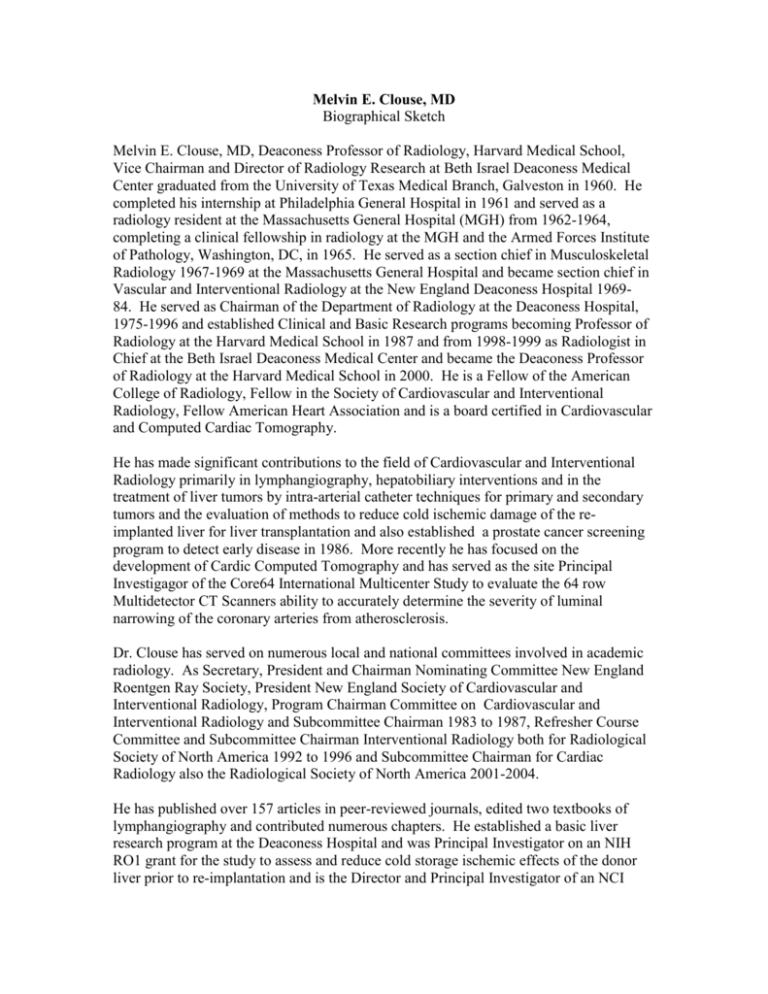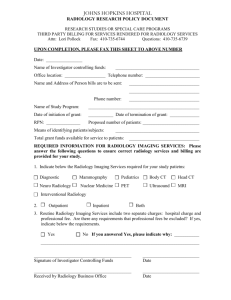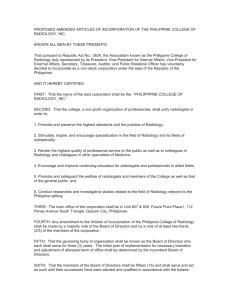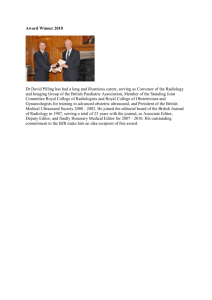MClouse简历
advertisement

Melvin E. Clouse, MD Biographical Sketch Melvin E. Clouse, MD, Deaconess Professor of Radiology, Harvard Medical School, Vice Chairman and Director of Radiology Research at Beth Israel Deaconess Medical Center graduated from the University of Texas Medical Branch, Galveston in 1960. He completed his internship at Philadelphia General Hospital in 1961 and served as a radiology resident at the Massachusetts General Hospital (MGH) from 1962-1964, completing a clinical fellowship in radiology at the MGH and the Armed Forces Institute of Pathology, Washington, DC, in 1965. He served as a section chief in Musculoskeletal Radiology 1967-1969 at the Massachusetts General Hospital and became section chief in Vascular and Interventional Radiology at the New England Deaconess Hospital 196984. He served as Chairman of the Department of Radiology at the Deaconess Hospital, 1975-1996 and established Clinical and Basic Research programs becoming Professor of Radiology at the Harvard Medical School in 1987 and from 1998-1999 as Radiologist in Chief at the Beth Israel Deaconess Medical Center and became the Deaconess Professor of Radiology at the Harvard Medical School in 2000. He is a Fellow of the American College of Radiology, Fellow in the Society of Cardiovascular and Interventional Radiology, Fellow American Heart Association and is a board certified in Cardiovascular and Computed Cardiac Tomography. He has made significant contributions to the field of Cardiovascular and Interventional Radiology primarily in lymphangiography, hepatobiliary interventions and in the treatment of liver tumors by intra-arterial catheter techniques for primary and secondary tumors and the evaluation of methods to reduce cold ischemic damage of the reimplanted liver for liver transplantation and also established a prostate cancer screening program to detect early disease in 1986. More recently he has focused on the development of Cardic Computed Tomography and has served as the site Principal Investigagor of the Core64 International Multicenter Study to evaluate the 64 row Multidetector CT Scanners ability to accurately determine the severity of luminal narrowing of the coronary arteries from atherosclerosis. Dr. Clouse has served on numerous local and national committees involved in academic radiology. As Secretary, President and Chairman Nominating Committee New England Roentgen Ray Society, President New England Society of Cardiovascular and Interventional Radiology, Program Chairman Committee on Cardiovascular and Interventional Radiology and Subcommittee Chairman 1983 to 1987, Refresher Course Committee and Subcommittee Chairman Interventional Radiology both for Radiological Society of North America 1992 to 1996 and Subcommittee Chairman for Cardiac Radiology also the Radiological Society of North America 2001-2004. He has published over 157 articles in peer-reviewed journals, edited two textbooks of lymphangiography and contributed numerous chapters. He established a basic liver research program at the Deaconess Hospital and was Principal Investigator on an NIH RO1 grant for the study to assess and reduce cold storage ischemic effects of the donor liver prior to re-implantation and is the Director and Principal Investigator of an NCI Training Program in Cancer Radiology that emphasizes the importance of the burgeoning field of molecular imaging and is responsible for the new Center for Molecular Imaging Diagnosis and Therapy, a radiology based initiative for the development of oncologic interventions at the cellular level. He considers gene therapy, with the diagnosis and therapeutic opportunities supported by molecular biotechnology to be an emerging radiology field. As knowledge advances the clinical demand for radiologists to deliver gene containing vectors to specific body sights will escalate. As Director of Research and Vice Chairman of Radiology (1996-2005) he is committed to preparing radiologists to take on this new and crucial direction in Radiology. During the past 14 years, He have evaluated the use of electron beam CT in clinical trials performing calcium studies of the coronary arteries using electron beam tomography and coronary arteriography comparing the ability of CT to standard coronary arteriograms to determine sensitivity specificity and accuracy of these techniques to coronary angiography. This interest has continued with the fast helical scanners currently using 64-row detectors of 0.5 millimeters as one is now able to visualize and accurately measure the amount of non-calcified plaque in major coronary arteries. This interest has resulted in numerous speaking engagements and publications resulting from collaboration with the Framingham Heart Study. The multi-center study using statin drugs and their effect on coronary artery calcification, Beyond Endorsed Lipid Lowering with EBCT scanning (BELLS Study) and Post Marketing Evaluation of the Effects of Protease Inhibitors on Fat Redistribution and Bone Density in HIVinfected patients receiving highly active antiviral retro viral therapy funded by Merk to evaluate the changes in total body fat over a five-year period. More recently, he was asked to serve as the site PI for a Toshiba-sponsored study using 64-row Detector MDCT to compare the accuracy of MDCTA to catheter coronary arteriography in 350 patients. This is a multi-center study of eight institutions, including: Johns Hopkins, Charite (Humboldt University, Berlin), Toronto General Hospital, IWATA in Japan, Heart Institute (InCor) Univerisity of SaoPaulo, Brazil, Leiden Unveristy, Netherlands and Mount Elizabeth, Singapore. During 2005 I join a collaborative effort with a group from the Joslin Clinic, Cardiology from Beth Israel Deaconess Medical Center and Tufts University, which resulted in the submission of (SCOOR: RFA-HA-05-001 Metabolic Syndrome, Inflammation and Vascular Remodeling) in April, 2005, that is currently under review. There has been wide spread interest in the medical area with respect to it’s utility for use and diagnosis of symptomatic as well as asymptomatic individuals and those that pose difficult diagnostic problems. The development of the MDCT-64 Scanners have made coronary artery scanning a clinically useful diagnostic tool although research studies continue. It is being used extensively throughout the US and more recently, Boston. The volume has increased markedly over the past month from an occasional coronary MDCTA to the present state, which we are now studying 5-6 cases per week. Growth is particularly exuberant in the Emergency Room, where the technique is used in patients with atypical chest pain when it is difficult to determine if the symptoms are related to pulmonary emboli early dissection or coronary artery disease. The technique involves a single or double injection for the coronary arteries and the chest for pulmonary emboli and dissection. The volume is projected to progress geometrically in the coming months. This has resulted in creating a nacent cardiac section where there is readout one to two times per week to teach cardiology and radiology residents in a collaborative manner and establish teaching and research programs. Research Funding Information: 1. 2 3. 4. 5. 6. 7. 8. 9. 10. 11. 12. 13. 1959, Public Health Service - National Institute of Neurological Diseases and Blindness. Clouse ME, Rigdon RH: The Pharmacological Action of Autonomic Drugs on the Eye of the Fowl. 1962, American Cancer Society Litwin SB, Fraley E, Clouse ME, Ulfelder H: Lymphography In-Patients with Pelvic Tumors. 1966, U.S.P.H Clouse ME, Hallgrimsson J, Wenlund DE: Complications Following Lymphography with Particular Reference to Pulmonary Oil Embolization 1971 Radiology Department, Massachusetts General Hospital, Boston, MA, Peabody Museum and Department of Anthropology, Harvard University and National Institute of General Medical Sciences and U.S. Public Health Services. Clouse ME, Damon A. Radiological Survey in the Solomon Islands, 1968, Lungs, Heart, Spleen, Scoliosis, Bone Age and Dental Development. 1982 Juvenile Diabetes Foundation, Soeldner JS, Kaldany A, Hill TC, Clouse ME. Diabetes: Pathogenesis, Detection and Oral Agents Assessment of Ultrasound B-scan Imaging for Detection and quantification of Atherosclerotic Lesions in Human Carotid and Iliofemoral Arteries, Grant RFP NHLBI 80-10 1985-1987 National Institute of Arthritis, Diabetes, Digestive and Kidney Diseases. Clouse ME, Preservation of Function in Donor Livers Assessed by NMR. PI 1991-1994, NIH Diabetes and Digestive Diseases, Clouse ME. Donor liver viability assessment by NMR and microscopy – Principal Investigator PI-1995-2000 National Cancer Institute, Clouse ME. The Deaconess Research Training in Cancer Radiology. CA 59367-01, Department of Radiological Sciences. PI-2000-2010 National Cancer Institute, Clouse ME. The Deaconess Research Training inCancer Radiology, CA 59367-06, Department of Radiology. PI (BIDMC)-CORE 64, International Multicenter Trial (3 US and 6 International sites) comparing MDCTA 64 with Catheter Coronary Arteriograms –Sponsor Toshiba Med. Systems PI_2005 - 2010 CA 59367-11 Department of Radiology, Beth Israel Deaconess SCOOR: RFA-HL-05-001 Director Imaging Core—Metabolic Syndrome, and Inflammation and Vascular Remodeling, May, 2005. 中文译文供参考 Melvin E. Clouse, 医学博士 简历 Melvin E. Clouse 是医学博士哈佛大学医学院放射学教授,哈佛大学附属 Beth Israel Deaconess 医院放射科名誉主席,放射科科研主任。1960 年毕业于得克萨斯医学 院。1961 年在费城总医院实习,1962-1964 年在哈佛大学麻省总医院担任住院医 生,并于 1965 年在麻省总医院和位于华盛顿特区的美军病理研究所完成放射科专 科训练。1969-1968 年担任麻省总医院放射科骨骼肌肉组负责人,1969-1984 年担 任 New England Deaconess 医院放射科血管和介入组负责人。1975-1996 年担任 Deaconess 医院放射科主任,期间建立了临床和基础研究项目,并于 1987 年成为哈 佛大学医学院正教授。1998-1999 年担任 Beth Israel Deaconess 医院主管放射科医 生。2000 年成为哈佛大学医学院 Deaconess 放射科讲座教授。系美国放射学会、心 脏学会、介入放射学会资深会员,执业心血管和心脏 CT 医师。 他在心血管和介入放射医学领域做出了很大的贡献,尤其是在血管造影、肝胆介 入、早中期肝癌动脉插管治疗、降低肝移植低温缺血损伤的评价方法等方面。他还 于 1986 年建立了一个前列腺癌筛检项目。近年来,他致力于心脏 CT 的开发,担 任了国际 64 排 CT 研究项目的负责人,研究动脉粥样硬化引起的的冠脉管腔狭窄 的危害性。 Clouse 医生曾在多个当地和全国性的放射医学学术委员会任职。曾担任新英格兰伦 琴学会秘书长、主席提名委员会成员;新英格兰心血管和介入放射学协会主席; 1983-1987 年,任北美放射学会心血管和介入分委会主席;1992-1996 年任北美放 射学会介入放射学进修课程分委会主席;2001-2004 年,任北美放射学会心脏放射 学分委会主席。 他在同行审稿的期刊上发表了 157 篇论文,编辑过两本淋巴血管造影的教科书,并 参与多部教科书相关章节的编写。他在 Deaconess 医院建立了基础肝癌研究项目, 担任国立卫生院 RO1 研究基金的项目负责人,研究降低肝移植低温缺血损伤的方 法。他还担任国家癌症研究所培训项目的负责人,倡导推广细胞水平的肿瘤干涉疗 法。他认为基于分子生物学的基因诊断是一个放射医学很有前景新领域,基因指针 能用于精确诊断。在担任研究主任和放射科副主席(1996-2005 年)期间,他积极 倡导放射科医生投身于这一新的领域。 在过去的 14 年中,他研究电子束 CT 在冠脉钙评分中的作用,比较了 CT 和普通冠 脉造影的诊断效果。目前,他继续在 64 排 0.5 毫米 CT 上进行该项研究,并发表了 多篇论文、受邀进行了多次讲座。 最近,他受邀担任东芝公司资助的 64 排 CT 研究项目的当地负责人,在 350 名病 人中比较 CT 血管造影和冠脉插管造影的准确性。 医学领域的新趋势是不但对有症状的病人进行诊断,而且对无症状和不典型症状的 病人进行诊断。64 排 CT 已经使冠脉扫描成为十分有效的诊断工具。冠脉扫描在波 士顿和美国得到了广泛的运用,临床病例数量显著地增加,达到每周 5-6 例,尤其 是在急诊病人当中。 获得科研基金资料(见英文原文)



